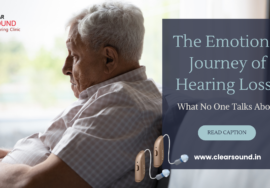
The Importance of Regular Hearing Check-up for All Ages
Whether in infancy, adulthood, or the golden years, prioritizing hearing health is necessary to ensure a vibrant & clear hearing.
Yet, the importance of maintaining good hearing health often goes unnoticed until problems arise. Regular hearing checkups are a vital aspect, ensuring that any issue relating to your hearing is identified early, allowing for timely hearing solutions.
Benefits of Regular Hearing Checkups…
The cornerstone of regular hearing checkups is the early detection of potential issues. Taking a step prevents hearing problems before they become more challenging to manage. This contributes to improved overall health outcomes, considering the interconnected nature of hearing health with broader aspects of our well-being.
Hearing Checkups at Different Life Stages…
Hearing checkups play a crucial role in maintaining auditory health across various life stages. The needs & challenges associated with hearing health evolve from infancy through adulthood to the senior years.
Infants & Children…
Early identification of hearing loss is especially critical during this year. For babies, hearing is integral to the development of speech & language skills. Even before a child speaks their first words, they absorb and process the sounds around them, laying the basis for their communication.
Regular hearing checkups for babies involve gentle screening tests that can detect potential hearing issues. These screenings are often conducted shortly after birth and during routine well-child visits. Early detection enables timely intervention such as the introduction of hearing aids or cochlear implants if needed.
As children grow, hearing tests remain vital. School-age children may face increased exposure to environmental noise and potential hearing challenges. Hearing tests can identify any issues affecting their academic performance, social interactions & overall well-being.
Adults…
Adulthood brings a unique set of challenges to hearing health. Occupational factors, lifestyle choices, and exposure to loud environments may contribute to hearing loss. Regular hearing checkups during adulthood are essential for monitoring changes & addressing potential issues.
Beyond the workplace, social activities can also influence hearing. Concerts, sporting events, and the use of personal audio devices at high volumes can contribute to hearing challenges.
Seniors…
Age-related hearing loss often progresses slowly, and individuals may not immediately recognize the changes.
In addition to age-related factors, seniors may encounter other conditions that impact hearing, such as diabetes. Comprehensive hearing checkups for seniors provide a broader view of health factors that may contribute to hearing challenges.
In essence, hearing screening is a lifelong necessity. From infancy to the senior years, regular evaluations ensure that potential hearing issues are identified & addressed promptly. Whether it’s ensuring a child’s language development, monitoring occupational noise exposure in adulthood, or addressing age-related changes in seniors, these tests are a proactive approach to maintaining optimal auditory health across the lifespan.
Signs & Symptoms of Hearing Issues…
Being aware of indicators is key to recognizing hearing issues. Common indicators include challenges in understanding speech, frequent requests for repetition, excessive volume adjustments & a tendency to withdraw from social interactions. If you observe these signs, seeking comprehensive hearing tests is advisable to address potential concerns effectively.
Importance of Professional Audiological Evaluation…
While recognizing signs is a critical first step, professional evaluation offers precision in identifying specific hearing issues. This, in turn, allows for the implementation of customized solutions based on the unique results of hearing tests. A comprehensive audiological evaluation provides detailed insights into the type and degree of hearing loss, enabling hearing care professionals to recommend personalized solutions.
Types of Hearing Tests…
Different types of hearing tests are employed to examine various aspects of auditory function. Let’s explore some common types:
Pure-Tone Audiometry…
Procedure: In a soundproof booth, the individual wears headphones and responds to tones of varying frequencies and volumes.
Purpose: Measures the softest sounds a person can hear at different frequencies.
Speech Audiometry…
Procedure: Evaluates the ability to hear and understand spoken words at various volumes.
Purpose: Assesses how well an individual can comprehend speech, providing insights into communication abilities.
Tympanometry…
Procedure: Involves placing a probe(a small, specialized device typically consisting of a sealed, airtight tip) in the ear to measure how the eardrum responds to changes in air pressure.
Purpose: Determines the health of the middle ear and identifies issues like fluid or earwax blockages.
Otoacoustic Emissions (OAE) Test…
Procedure: A tiny probe with a microphone is placed in the ear to measure sound responses produced by the inner ear (cochlea).
Purpose: Check the health of the hair cells, crucial for normal hearing.
Auditory Brainstem Response (ABR) Test…
Procedure: Electrodes are placed on the scalp to record electrical activity in response to sound stimuli.
Purpose: Assesses the auditory nerve and brainstem function, useful in diagnosing neural hearing loss.
Speech-in-Noise Testing…
Procedure: Measures the ability to understand speech in noisy environments.
Purpose: Mimics real-life situations and assesses how well an individual can comprehend speech amid background noise.
Real Ear Measurement (REM)…
Procedure: Involves placing a tiny microphone in the ear canal to measure the actual sound levels produced by a hearing aid.
Purpose: Ensures hearing aids are calibrated correctly for individual hearing needs.
Video Otoscopy…
Procedure: Uses a small camera to examine the ear canal and eardrum.
Purpose: Provides a visual assessment of the ear’s health, identifying any abnormalities or blockages.
High-Frequency Audiometry…
Procedure: Similar to pure-tone audiometry but focuses on higher frequencies.
Purpose: Evaluate hearing sensitivity in the extended high-frequency range, important for specific occupations & early detection of certain hearing issues.
These diverse hearing tests, performed by qualified audiologists, collectively provide a comprehensive understanding of an individual’s hearing abilities and help tailor appropriate interventions if needed.
Technological Advancements in Hearing Health…
The field of hearing health has witnessed remarkable technological innovations, transforming the way individuals experience sound & addressing various hearing challenges.
Bluetooth Connectivity…
Direct Streaming: Smart hearing aids come equipped with Bluetooth technology enabling seamless communication with compatible devices such as smartphones & televisions.
Customizable Settings: These aids offer personalized & adjustable settings, allowing users to fine-tune their hearing experience according to their preferences.
Rechargeable Batteries…
Convenience: Rechargeable hearing aids offer unparalleled convenience ensuring continuous usage without the need for frequent battery changes.
Cost-Effectiveness: Users benefit from a cost-effective solution as rechargeable batteries prove more economical over the long term.
Noise Reduction Technology…
Enhanced Speech Intelligibility: By minimizing background noise, this technology enhances speech intelligibility, especially in bustling environments.
Stress-Free Listening: Users can enjoy a more enjoyable & stress-free listening experience, focusing on the sounds they want to hear.
Waterproof Hearing Aids…
Protection Against Water Damage: Waterproof hearing aids provide a protective shield against water damage, ensuring the devices remain functional even in wet conditions.
Durability: This feature enhances the overall durability of hearing aids contributing to a longer lifespan.
Directional Microphones…
Focused Sound Capture: These microphones focus on specific sounds or voices while minimizing background noise, allowing users to better understand conversations in noisy environments.
Improved Speech Clarity: By emphasizing the targeted sound source, directional microphones significantly improve speech clarity, especially in challenging acoustic settings.
So, with this diverse range of hearing aids, there’s a perfect match for every individual’s needs & preferences.
Professional Hearing screening…
At Clear Sound, Hearing & Speech Clinic, our team of dedicated & experienced audiologists is committed to providing thorough and precise comprehensive hearing tests. Utilizing advanced technology and adopting a patient-centric approach, Clear Sound strives to empower individuals on their journey to achieving clear & vibrant hearing.
Our clinic is open to individuals like you who are seeking professional hearing checkups. We invite you to visit our state-of-the-art facility where our skilled audiologists will conduct detailed evaluations to assess your hearing health.
Taking a proactive step towards hearing checkups at Clear Sound means receiving the highest standard of care.
Schedule an appointment at our Delhi, Gurugram or Prayagraj clinic & let us be your partner in achieving optimal hearing health…








